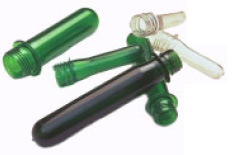PET Bottle Manufacturing And Color Measurement

•Article: PET Bottle Manufacturing And Color Measurement
The plastic bottle industry has many producers, each striving to manufacture high quality products. Properties such as barrier characteristics, dimensional stability, shape and appearance are of significant importance. Appearance attributes can include reflected color, transmitted color, yellowness, and haze. For some applications the presence of proper levels of UV inhibitors is also important. The use of color measurement instrumentation to test and quantitate these attributes will ensure customer satisfaction and aid in reducing costs.
General Principles
There are two basic types of color measurement instruments, tristimulus colorimeters and colorimetric
spectrophotometers. These instruments are categorized as psychophysical measurement instruments,
meaning they are designed to give measurements that correlate with the human eye-brain impressions. They
have built in characteristics that simulate the operation of the eye and brain in judgements of color appearance.
The tristimulus colorimeter uses colored glass filters to simulate the human eye response to light and
today finds limited application in the plastics industry. On the other hand, the more versatile colorimetric
spectrophotometer is widely used in the plastics industry. It measures the wavelength distribution of light
reflected or transmitted by a sample and this data is used to calculate color values. Instrument geometry
generally falls into one of two categories: 45°/0°geometry or sphere (d/8°) geometry. For 45°/0° geometry
instruments, the source light illuminates the sample at 45° and the light reflected at 0° (normal to the surface)
is measured. The 45°/0°geometry instruments exclude the specular (gloss) component of reflected light
meaning that the color they measure will be due to both sample pigmentation and sample surface characteristics.
Frequently 45°/0°geometry instruments have measurement ports that are at least 2" in diameter giving
a good optical average when measuring samples such as pellets. With sphere (d/8°) instruments the source
light is projected into a sphere and is diffused by the sphere coating. This diffused light is incident on the
sample and the light reflected at 8° is measured. Typically sphere instruments include
the specular (gloss) component in the measurement meaning the color they
measure will be due to sample pigmentation only. Instruments with sphere
geometry normally have the added ability to measure transmitted color and
haze in addition to reflected color.
Click Here To Download:
•Article: PET Bottle Manufacturing And Color Measurement
SOURCE: HunterLab - Measure Color...Measure Quality
